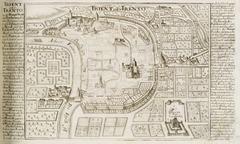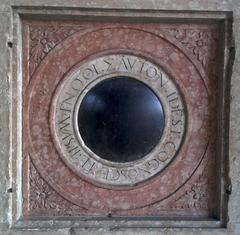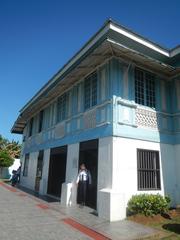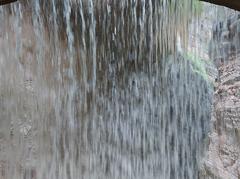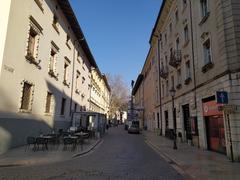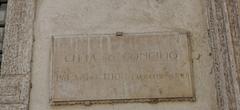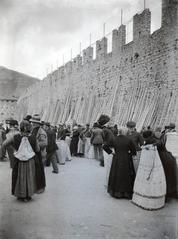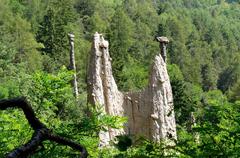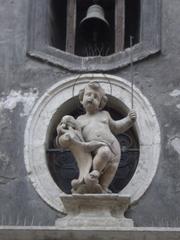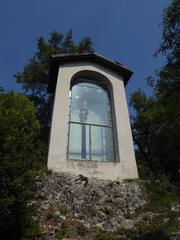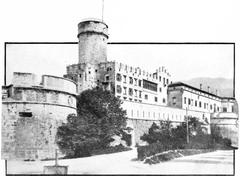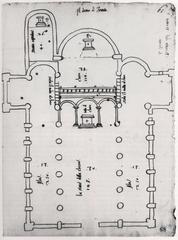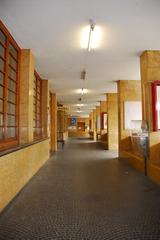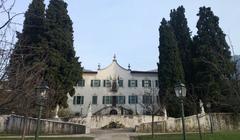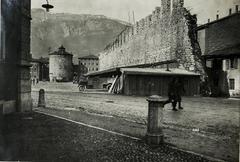
Palazzo delle Albere Visiting Guide: Hours, Tickets, and Tips
Date: 19/07/2024
Introduction
Palazzo delle Albere, a prominent Renaissance villa located in Trento, Italy, offers a unique blend of historical significance and modern cultural relevance. Constructed between 1550 and 1560 by the influential Madruzzo family, this villa not only served as a fortified residence but also played a crucial role during the Council of Trent, a major ecumenical council of the Catholic Church (MART). The architectural design, attributed to Giovanni Maria Falconetto, reflects the dual purpose of the villa as both a noble residence and a fortress, characterized by its rectangular plan and four corner towers. The interior is adorned with elaborate frescoes and stucco decorations, showcasing scenes from classical mythology and the history of the Madruzzo family (MUSE). Today, Palazzo delle Albere is managed by the Autonomous Province of Trento and serves as a cultural and exhibition center, housing the Museum of Modern and Contemporary Art of Trento and Rovereto (MART). The villa hosts a variety of exhibitions, cultural events, and educational programs, making it a significant cultural hub in the region (Trentino Cultura). This comprehensive guide aims to provide visitors with all the necessary information, from historical context and architectural details to visiting hours, ticket information, and travel tips, ensuring a memorable experience at Palazzo delle Albere.
Table of Contents
- Origins and Construction
- Architectural Design
- The Madruzzo Family
- Role in the Council of Trent
- Decline and Restoration
- Modern Use and Cultural Significance
- Visitor Information (Tickets, Visiting Hours)
- Travel Tips and Nearby Attractions
- Educational Programs
- Future Prospects
- Notable Events and Exhibitions
- Preservation Efforts
- Visitor Experience
- FAQ
Discover the Rich History and Modern Wonders of Palazzo delle Albere in Trento
Origins and Construction
The Palazzo delle Albere, located in Trento, Italy, is a Renaissance villa that dates back to the 16th century. It was constructed between 1550 and 1560 by the Madruzzo family, a prominent noble family in the region. The villa was originally built as a fortified residence, reflecting the architectural style and defensive needs of the period. The name “Albere” is derived from the rows of poplar trees (alberi in Italian) that once surrounded the estate.
Architectural Design
The design of Palazzo delle Albere is attributed to the architect Giovanni Maria Falconetto, who was known for his work in the Renaissance style. The villa features a rectangular plan with four corner towers, giving it a fortress-like appearance. The exterior is characterized by its austere stone façade, while the interior boasts elaborate frescoes and stucco decorations. The frescoes, which depict scenes from classical mythology and the history of the Madruzzo family, were created by artists from the school of Giulio Romano.
The Madruzzo Family
The Madruzzo family played a significant role in the history of Trento and the broader region. They were influential in both political and religious spheres, with several family members serving as prince-bishops of Trento. The construction of Palazzo delle Albere was part of their efforts to consolidate their power and demonstrate their wealth and status. The villa served as a residence for the family and a venue for hosting important guests and events.
Role in the Council of Trent
Palazzo delle Albere holds historical significance due to its association with the Council of Trent (1545-1563), a major ecumenical council of the Catholic Church. The council was convened in response to the Protestant Reformation and aimed to address issues of church reform and doctrine. Members of the Madruzzo family, particularly Cristoforo Madruzzo, played key roles in the council. The villa served as a meeting place for council participants and a residence for some of the attendees.
Decline and Restoration
Following the decline of the Madruzzo family in the 17th century, Palazzo delle Albere fell into disrepair. The villa changed hands several times and was used for various purposes, including as a military barracks and a warehouse. In the 20th century, efforts were made to restore the villa and preserve its historical and architectural significance. Restoration work began in the 1970s, focusing on stabilizing the structure and conserving the frescoes and other interior decorations.
Modern Use and Cultural Significance
Today, Palazzo delle Albere is managed by the Autonomous Province of Trento and serves as a cultural and exhibition center. It houses the Museum of Modern and Contemporary Art of Trento and Rovereto (MART), which features a collection of 20th and 21st-century art. The villa also hosts temporary exhibitions, cultural events, and educational programs, making it an important cultural hub in the region.
Visitor Information (Tickets, Visiting Hours)
Visitors to Palazzo delle Albere can explore its rich history and architectural beauty through guided tours and exhibitions. The villa is open to the public from Tuesday to Sunday, with visiting hours from 10 AM to 6 PM. Tickets can be purchased on-site or through the official MART website. Special rates are available for students, seniors, and groups.
Travel Tips and Nearby Attractions
When visiting Palazzo delle Albere, consider exploring nearby attractions in Trento. The city is home to historical sites such as the Trento Cathedral and Buonconsiglio Castle. Additionally, the scenic views of the Adige River and the surrounding gardens of the villa offer a serene and picturesque setting. For those interested in local cuisine, Trento boasts several renowned restaurants and cafes.
Educational Programs
Palazzo delle Albere also plays a role in education and research. It hosts educational programs for students, scholars, and the general public, focusing on art, history, and cultural heritage. These programs aim to promote understanding and appreciation of the villa’s historical significance and its contributions to the cultural landscape of Trento and beyond.
Future Prospects
Looking ahead, the future of Palazzo delle Albere involves balancing preservation with innovation. Plans are in place to enhance the visitor experience through the use of digital technologies, such as virtual tours and interactive exhibits. These initiatives aim to make the villa’s rich history and cultural offerings accessible to a wider audience, both locally and globally.
Notable Events and Exhibitions
Over the years, Palazzo delle Albere has hosted numerous notable events and exhibitions. These have included retrospectives of prominent artists, thematic exhibitions on various aspects of modern and contemporary art, and cultural festivals. The villa’s unique historical and architectural setting provides a distinctive backdrop for these events, enhancing their appeal and significance.
Preservation Efforts
Preservation of Palazzo delle Albere is an ongoing effort, involving collaboration between local authorities, cultural organizations, and conservation experts. The goal is to maintain the villa’s structural integrity and historical authenticity while adapting it for modern use. This includes regular maintenance, restoration of damaged elements, and implementation of measures to protect the villa from environmental and human-induced threats.
Visitor Experience
Visitors to Palazzo delle Albere can explore its rich history and architectural beauty through guided tours and exhibitions. The villa’s location in Trento, a city known for its historical and cultural heritage, makes it a popular destination for tourists. The surrounding gardens and the scenic views of the Adige River add to the appeal, offering a serene and picturesque setting for visitors.
FAQ
Q - What are the visiting hours for Palazzo delle Albere?
A - The villa is open to the public from Tuesday to Sunday, with visiting hours from 10 AM to 6 PM.
Q - How can I purchase tickets for Palazzo delle Albere?
A - Tickets can be purchased on-site or through the official MART website. Special rates are available for students, seniors, and groups.
Q - Are there guided tours available?
A - Yes, guided tours are available and can be booked in advance. Check the official MART website for more details.
Q - What nearby attractions should I visit in Trento?
A - Nearby attractions include the Trento Cathedral, Buonconsiglio Castle, and the scenic Adige River.
Visit and Stay Up to Date
For more detailed information on the history and current use of Palazzo delle Albere, you can visit the official MART website. Stay updated on upcoming events and exhibitions by following MART on social media or downloading their mobile app.
Conclusion
In summary, Palazzo delle Albere is not just a historical monument but a vibrant cultural center that continues to play a significant role in the cultural landscape of Trento. From its origins in the 16th century as a fortified residence built by the Madruzzo family to its modern-day function as a museum and exhibition center, the villa offers a rich tapestry of history, art, and culture. The ongoing preservation efforts ensure that the architectural and artistic heritage of the villa is maintained for future generations. Visitors can explore the villa’s elaborate frescoes, participate in guided tours, and enjoy a variety of exhibitions and events throughout the year. The strategic location of Palazzo delle Albere near other notable attractions in Trento, such as the Trento Cathedral and Buonconsiglio Castle, makes it a must-visit destination for anyone interested in the region’s rich history and cultural heritage. Whether you are a history enthusiast, an art lover, or simply looking for a picturesque and educational outing, Palazzo delle Albere offers something for everyone. For more information and to stay updated on upcoming events, visit the official MART website or follow them on social media.
References
- Discover the Rich History and Modern Wonders of Palazzo delle Albere in Trento. 2024. MART
- A Guide to Palazzo delle Albere - History, Visiting Hours, and Tickets in Trento. 2024. MUSE
- Visitor Guide to Palazzo delle Albere - Tickets, Hours, and Tips for Trento’s Historic Gem. 2024. Trentino Cultura
